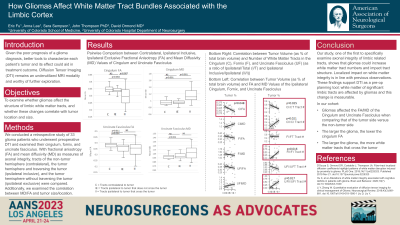How Gliomas Affect White Matter Tract Bundles Associated with the Limbic Cortex
Friday, April 21, 2023


Eric Fu, MS (he/him/his)
Medical Student
University of Colorado School of Medicine
Aurora, Colorado, United States
ePoster Presenter(s)
Introduction: While glioma incidence in the US has stabilized, prognosis remains poor. One underutilized MRI modality, Diffusion Tensor Imaging (DTI), could be used to better predict postoperative glioma resection outcomes. DTI measures the structural integrity of brain white matter tracts by measuring water diffusion. We examined whether lateralized gliomas affected the structure of limbic tract bundles, and whether those changes correlated with tumor location, size, and number of tracts within the bundle.
Methods: We conducted a retrospective study of 33 glioma patients who underwent preoperative DTI and examined the cingulum, fornix, and uncinate fasciculus. Using software (ITK-SNAP, DSI Studio), we obtained diffusion coefficients (fractional anisotropy (FA), mean diffusivity (MD)), tumor volume, lobe location, and tract number. With FA and MD as measures of axonal integrity, tracts of the non-tumor hemisphere (contralateral), the tumor hemisphere that is traversing the tumor (ipsilateral inclusive), and the tumor hemisphere without traversing the tumor (ipsilateral exclusive) were compared. Additionally, we correlated these hemispheric changes to tumor size, location, and FA/MD.
Results: In the fornix, FA and MD are significantly different between contralateral and ipsilateral inclusive and between ipsilateral exclusive versus ipsilateral inclusive. Similar findings were found in the uncinate fasciculus MD. FA and MD of cingulum, fornix, and uncinate fasciculus are significantly correlated with the number of tracts within the tumor hemisphere.
Conclusion : Our study, one of the first to specifically examine limbic related tracts, shows that gliomas could increase white matter tracts numbers and impact structure. Localized impact on white matter integrity is in line with previous observations.
These findings support DTI as a pre-op planning tool; white matter of significant limbic tracts are affected by gliomas and this change is measurable. We plan on further analyzing data to include how tumor location could affect white matter, and to incorporate patient post-op mortality and morbidity.
Methods: We conducted a retrospective study of 33 glioma patients who underwent preoperative DTI and examined the cingulum, fornix, and uncinate fasciculus. Using software (ITK-SNAP, DSI Studio), we obtained diffusion coefficients (fractional anisotropy (FA), mean diffusivity (MD)), tumor volume, lobe location, and tract number. With FA and MD as measures of axonal integrity, tracts of the non-tumor hemisphere (contralateral), the tumor hemisphere that is traversing the tumor (ipsilateral inclusive), and the tumor hemisphere without traversing the tumor (ipsilateral exclusive) were compared. Additionally, we correlated these hemispheric changes to tumor size, location, and FA/MD.
Results: In the fornix, FA and MD are significantly different between contralateral and ipsilateral inclusive and between ipsilateral exclusive versus ipsilateral inclusive. Similar findings were found in the uncinate fasciculus MD. FA and MD of cingulum, fornix, and uncinate fasciculus are significantly correlated with the number of tracts within the tumor hemisphere.
Conclusion : Our study, one of the first to specifically examine limbic related tracts, shows that gliomas could increase white matter tracts numbers and impact structure. Localized impact on white matter integrity is in line with previous observations.
These findings support DTI as a pre-op planning tool; white matter of significant limbic tracts are affected by gliomas and this change is measurable. We plan on further analyzing data to include how tumor location could affect white matter, and to incorporate patient post-op mortality and morbidity.
